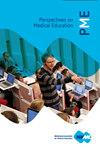数字证据:重新审视技术与评估交叉点上的假设。
IF 3.9
2区 医学
Q1 EDUCATION, SCIENTIFIC DISCIPLINES
Perspectives on Medical Education
Pub Date : 2024-11-20
eCollection Date: 2024-01-01
DOI:10.5334/pme.1270
引用次数: 0
摘要
技术在医疗保健和卫生专业教育中的应用日益增多,这就要求我们研究如何利用数字证据来源来提出评估要求。在本文中,我们描述了四组术语--主要数据和次要数据;结构化数据和非结构化数据;开发和使用;确定性数据和生成性数据--如何帮助研究如何将数字来源的数据用于评估学习者的知识和能力。本文通过多个实例说明了这四组术语如何帮助基于技术的评估系统的开发者和使用者。本文章由计算机程序翻译,如有差异,请以英文原文为准。
Digital Evidence: Revisiting Assumptions at the Intersection of Technology and Assessment.
The increasing use of technology in health care and health professions education is an invitation to examine how digital sources of evidence are used in making assessment claims. In this paper, we describe how four sets of terms-primary and secondary data; structured and unstructured data; development and use; and deterministic and generative-can aid in examining how data from digital sources are used in evaluating what learners know and can do. Drawing on multiple examples, this paper shows how the four sets of terms can help both developers and users of technology-based assessment systems.
求助全文
通过发布文献求助,成功后即可免费获取论文全文。
去求助
来源期刊

Perspectives on Medical Education
Multiple-
CiteScore
5.70
自引率
8.30%
发文量
31
审稿时长
28 weeks
期刊介绍:
Perspectives on Medical Education mission is support and enrich collaborative scholarship between education researchers and clinical educators, and to advance new knowledge regarding clinical education practices.
Official journal of the The Netherlands Association of Medical Education (NVMO).
Perspectives on Medical Education is a non-profit Open Access journal with no charges for authors to submit or publish an article, and the full text of all articles is freely available immediately upon publication, thanks to the sponsorship of The Netherlands Association for Medical Education.
Perspectives on Medical Education is highly visible thanks to its unrestricted online access policy.
Perspectives on Medical Education positions itself at the dynamic intersection of educational research and clinical education. While other journals in the health professional education domain orient predominantly to education researchers or to clinical educators, Perspectives positions itself at the collaborative interface between these perspectives. This unique positioning reflects the journal’s mission to support and enrich collaborative scholarship between education researchers and clinical educators, and to advance new knowledge regarding clinical education practices. Reflecting this mission, the journal both welcomes original research papers arising from scholarly collaborations among clinicians, teachers and researchers and papers providing resources to develop the community’s ability to conduct such collaborative research. The journal’s audience includes researchers and practitioners: researchers who wish to explore challenging questions of health professions education and clinical teachers who wish to both advance their practice and envision for themselves a collaborative role in scholarly educational innovation. This audience of researchers, clinicians and educators is both international and interdisciplinary.
The journal has a long history. In 1982, the journal was founded by the Dutch Association for Medical Education, as a Dutch language journal (Netherlands Journal of Medical Education). As a Dutch journal it fuelled educational research and innovation in the Netherlands. It is one of the factors for the Dutch success in medical education. In 2012, it widened its scope, transforming into an international English language journal. The journal swiftly became international in all aspects: the readers, authors, reviewers and editorial board members.
The editorial board members represent the different parental disciplines in the field of medical education, e.g. clinicians, social scientists, biomedical scientists, statisticians and linguists. Several of them are leading scholars. Three of the editors are in the top ten of most cited authors in the medical education field. Two editors were awarded the Karolinska Institute Prize for Research. Presently, Erik Driessen leads the journal as Editor in Chief.
Perspectives on Medical Education is highly visible thanks to its unrestricted online access policy. It is sponsored by theThe Netherlands Association of Medical Education and offers free manuscript submission.
Perspectives on Medical Education positions itself at the dynamic intersection of educational research and clinical education. While other journals in the health professional education domain orient predominantly to education researchers or to clinical educators, Perspectives positions itself at the collaborative interface between these perspectives. This unique positioning reflects the journal’s mission to support and enrich collaborative scholarship between education researchers and clinical educators, and to advance new knowledge regarding clinical education practices. Reflecting this mission, the journal both welcomes original research papers arising from scholarly collaborations among clinicians, teachers and researchers and papers providing resources to develop the community’s ability to conduct such collaborative research. The journal’s audience includes researchers and practitioners: researchers who wish to explore challenging questions of health professions education and clinical teachers who wish to both advance their practice and envision for themselves a collaborative role in scholarly educational innovation. This audience of researchers, clinicians and educators is both international and interdisciplinary.
The journal has a long history. In 1982, the journal was founded by the Dutch Association for Medical Education, as a Dutch language journal (Netherlands Journal of Medical Education). As a Dutch journal it fuelled educational research and innovation in the Netherlands. It is one of the factors for the Dutch success in medical education. In 2012, it widened its scope, transforming into an international English language journal. The journal swiftly became international in all aspects: the readers, authors, reviewers and editorial board members.
The editorial board members represent the different parental disciplines in the field of medical education, e.g. clinicians, social scientists, biomedical scientists, statisticians and linguists. Several of them are leading scholars. Three of the editors are in the top ten of most cited authors in the medical education field. Two editors were awarded the Karolinska Institute Prize for Research. Presently, Erik Driessen leads the journal as Editor in Chief.
Perspectives on Medical Education is highly visible thanks to its unrestricted online access policy. It is sponsored by theThe Netherlands Association of Medical Education and offers free manuscript submission.
 求助内容:
求助内容: 应助结果提醒方式:
应助结果提醒方式:


